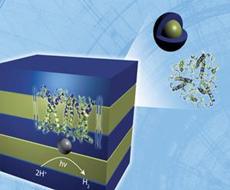'Tall order' sunlight-to-hydrogen system works, neutron analysis confirms
12 Feb 2011
Researchers at the Department of Energy's Oak Ridge National Laboratory have developed a biohybrid photoconversion system -- based on the interaction of photosynthetic plant proteins with synthetic polymers -- that can convert visible light into hydrogen fuel.
 |
| Neutron scattering analysis performed at DOE's Oak Ridge National Laboratory reveals the lamellar structure of a hydrogen-producing, biohybrid composite material formed by the self-assembly of naturally occurring, light harvesting proteins with polymers. |
Photosynthesis, the natural process carried out by plants, algae and some bacterial species, converts sunlight energy into chemical energy and sustains much of the life on earth.
Researchers have long sought inspiration from photosynthesis to develop new materials to harness the sun's energy for electricity and fuel production.
In a step toward synthetic solar conversion systems, the ORNL researchers have demonstrated and confirmed with small-angle neutron scattering analysis that light harvesting complex II (LHC-II) proteins can self-assemble with polymers into a synthetic membrane structure and produce hydrogen.
The researchers envision energy-producing photoconversion systems similar to photovoltaic cells that generate hydrogen fuel, comparable to the way plants and other photosynthetic organisms convert light to energy.
"Making a self-repairing synthetic photoconversion system is a pretty tall order. The ability to control structure and order in these materials for self-repair is of interest because, as the system degrades, it loses its effectiveness," ORNL researcher Hugh O'Neill, of the lab's Center for Structural Molecular Biology, said.
"This is the first example of a protein altering the phase behavior of a synthetic polymer that we have found in the literature.


.webp)




























